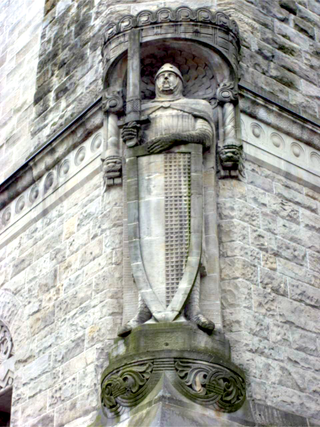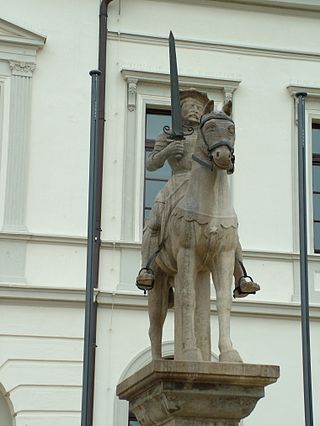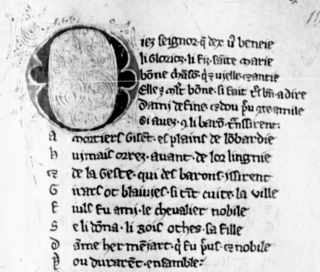Related Research Articles

Roland was a Frankish military leader under Charlemagne who became one of the principal figures in the literary cycle known as the Matter of France. The historical Roland was military governor of the Breton March, responsible for defending Francia's frontier against the Bretons. His only historical attestation is in Einhard's Vita Karoli Magni, which notes he was part of the Frankish rearguard killed in retribution by the Basques in Iberia at the Battle of Roncevaux Pass.

The chanson de geste is a medieval narrative, a type of epic poem that appears at the dawn of French literature. The earliest known poems of this genre date from the late 11th and early 12th centuries, shortly before the emergence of the lyric poetry of the troubadours and trouvères, and the earliest verse romances. They reached their highest point of acceptance in the period 1150–1250.

Renaud de Montauban was a legendary hero and knight which appeared in a 12th-century Old French chanson de geste known as The Four Sons of Aymon. The four sons of Duke Aymon are Renaud, Richard, Alard and Guiscard, and their cousin is the magician Maugris. Renaud possesses the magical horse Bayard and the sword Froberge.
The Matter of France, also known as the Carolingian cycle, is a body of literature and legendary material associated with the history of France, in particular involving Charlemagne and his associates. The cycle springs from the Old French chansons de geste, and was later adapted into a variety of art forms, including Renaissance epics and operas. Together with the Matter of Britain, which concerned King Arthur, and the Matter of Rome, comprising material derived from and inspired by classical mythology, it was one of the great European literary cycles that figured repeatedly in medieval literature.
Durendal, also spelled Durandal, is the sword of Roland, a legendary paladin and partially historical officer of Charlemagne in French epic literature. It is also said to have belonged to young Charlemagne at one point, and, passing through Saracen hands, came to be owned by Roland.

Medieval French literature is, for the purpose of this article, Medieval literature written in Oïl languages during the period from the eleventh century to the end of the fifteenth century.

Maugris or Maugis was one of the heroes of the chansons de geste and romances of chivalry and the Matter of France that tell of the legendary court of King Charlemagne. Maugis was cousin to Renaud de Montauban and his brothers, son of Beuves of Aygremont and brother to Vivien de Monbranc. He was brought up by Oriande the fairy, and became a great enchanter. He won the magical horse Bayard and the sword Froberge which he later gave to Renaud.

Oliver, sometimes referred to as Olivier de Vienne or de Gennes, is a legendary knight in the Matter of France chansons de geste, especially the French epic The Song of Roland. In the tradition, he was Roland's closest friend, advisor, confidant and brother-in-law to be, one of Charlemagne's twelve peers and brother of Aude, Roland's betrothed. He dies with Roland at the Battle of Roncevaux Pass. Some critics have linked his name to the olive tree, a biblical symbol of divine wisdom.

Fierabras or Ferumbras is a fictional Saracen knight appearing in several chansons de geste and other material relating to the Matter of France. He is the son of Balan, king of Spain, and is frequently shown in conflict with Roland and the Twelve Peers, especially Oliver, whose prowess he almost rivals. Fierabras eventually converts to Christianity and fights for Charlemagne.
Historia Caroli Magni, also known as Historia Karoli Magni et Rotholandi and sometimes as the Turpin Chronicle or the Pseudo-Turpin Chronicle, is a 12th-century Latin forged chronicle of legendary material about Charlemagne's alleged conquest of Spain. It is also called Book IV – The Conquests of Charlemagne of the Codex Calixtinus. The chronicle states it was written by Charlemagne's contemporary Turpin, Archbishop of Reims, but it was found out as a medieval forgery. The work was extremely popular, and served as a major source of material on Charlemagne in chronicles, fiction and iconography throughout Medieval Europe. The miracles of the flowering lances and the death of Ferracutus appear on the windows of Chartres cathedral.
Andrea Mangiabotti, called Andrea da Barberino was an Italian writer and cantastorie ("storyteller") of the Quattrocento Renaissance. He was born in Barberino Val d'Elsa, near Florence and lived in Florence. He is principally known for his prose romance epic Il Guerrin Meschino, his I Reali di Francia, a prose compilation of the Matter of France epic material concerning Charlemagne and Roland (Orlandino) from various legends and chansons de geste, and for his Aspramonte, a reworking of the chanson de geste Aspremont, which also features the hero Ruggiero. Many of his writings probably derive from Franco-Italian works, such as the Geste Francor, that includes versions of the stories of Reali di Francia and dates to the first half of the fourteenth century. His works, which circulated at first in manuscript, were extremely successful and popular, and were a key source of material for later Italian romance writers, such as Luigi Pulci (Morgante), Matteo Maria Boiardo and Ludovico Ariosto.
Agolant or Agolante is a fictional character in Medieval and Renaissance romantic epics dealing with the Matter of France, including Orlando innamorato by Matteo Maria Boiardo and Orlando furioso by Ludovico Ariosto. He is a Saracen king from Africa.

Veillantif (French), Vielantiu ; Vegliantin, Vegliantino or Brigliadoro (Italian) is the name of Roland the paladin's trustworthy and swift steed in the stories derived from the chansons de geste. The French name comes from an expression meaning "vigilant". Veillantif is first mentioned in The Song of Roland.

The Karlamagnús saga, Karlamagnussaga or Karlamagnus-saga was a late-thirteenth-century Norse prose compilation and adaptation, made for Haakon V of Norway, of the Old French chansons de geste of the Matter of France dealing with Charlemagne and his paladins. In some cases, the Karlamagnús saga remains the only source for otherwise-lost Old French epics.
Girart de Vienne is a late twelfth-century (c.1180) Old French chanson de geste by Bertrand de Bar-sur-Aube. The work tells the story of the sons of Garin de Monglane and their battles with the Emperor Charlemagne, and it establishes the friendship of the epic heroes Olivier and Roland.
Aymeri de Narbonne is a legendary hero of Old French chansons de geste and the Matter of France. In the legendary material, as elaborated and expanded in various medieval texts, Aymeri is a knight in the time of Charlemagne's wars with the Saracens after the Battle of Roncevaux Pass. He is son of Hernaut and the grandson of Garin de Monglane. He conquers the city of Narbonne, marries a princess named Hermengarde or Hermenjart, and fathers seven sons, the most famous being Guillaume d'Orange, the hero of several popular chansons de geste.
The Chanson de Guillaume, also called Chançun de Willame, is a chanson de geste from the first half of the twelfth-century. The work is generally considered to have two distinct halves: the first tells of Guillaume of Orange, his nephew Vivien and the latter's young brother Gui and their various battles with Saracens at L'Archamp; in the second half of the poem, Guillaume is aided by Rainouard, a giant.

Galiens li Restorés, or Galien le Restoré or Galien rhétoré, is an Old French chanson de geste which borrows heavily from chivalric romance. Its composition dates anywhere from the end of the twelfth century to the middle of the fourteenth century. Five versions of the tale are extant, dating from the fifteenth century to the sixteenth century, one in verse and the others in prose. The story—which is closely linked to the earlier chansons de gestePèlerinage de Charlemagne and The Song of Roland —tells of the adventures of Galien, son of the hero Olivier and of Jacqueline, the daughter of the (fictional) emperor Hugon of Constantinople.
The Geste du roi is the title of one of the literary cycles that compose the Chansons de Geste. In the Chansons of the Geste du roi, the chief character is usually Charlemagne or one of his immediate successors. A pervasive theme is the King's role as champion of Christianity. This cycle contains the first of the chansons to be written down, the Chanson de Roland or The Song of Roland.

Jordain de Blaivies is an Old French chanson de geste written in decasyllables around 1200. It is an adventure story, largely inspired by the ancient story of Apollonius of Tyre. It survives in a single manuscript. The original was never popular, but it was reworked into a different metre and also adapted into prose in the 15th century. The prose version was printed with illustrations in 1520.
References
- Citations
- ↑ Ward, H. L. D. (1883), "Royal 15. E. vi. f. 43–69b: Aspremont", Catalogue of Romances in the Department of Manuscripts in the British Museum, vol. 1, pp. 601–602
- ↑ Hasenohr, 106.
- ↑ Holmes, 83.
- ↑ Brandin (1919–1921), passim.
- 1 2 Ward, H. L. D. (1883), "Lansdowne 782: Chanson 'Aspremont", Catalogue of Romances in the Department of Manuscripts in the British Museum, pp. 601–602
- 1 2 Brandin (1919–1921).
- ↑ Newth (1989), pp. 269–271.
- ↑ Newth (1989), pp. 146–7.
- ↑ British Library Images Online fol. 23v
- ↑ Newth (1989), p. 180.
- Bibliography
- Geneviève Hasenohr and Michel Zink, eds. Dictionnaire des lettres françaises: Le Moyen Age. Collection: La Pochothèque. Paris: Fayard, 1992. pp. 106–7. ISBN 2-253-05662-6 (in French)
- Holmes, Jr, Urban Tigner [U.T.]. A History of Old French Literature from the Origins to 1300. New York: F.S. Crofts, 1938. p. 83.
- Newth, Michael A. (tr. & ed.) (1989), The Song of Aspremont (La Chanson d'Aspremont, New York: Garland
- Brandin, Louis (1919), La Chanson d'Aspremont: chanson de geste du XII ̇siècle: Text du manuscrit de Wollaton Hall, vol. 1, Paris: Honoré Champion; volume 2 (1921).